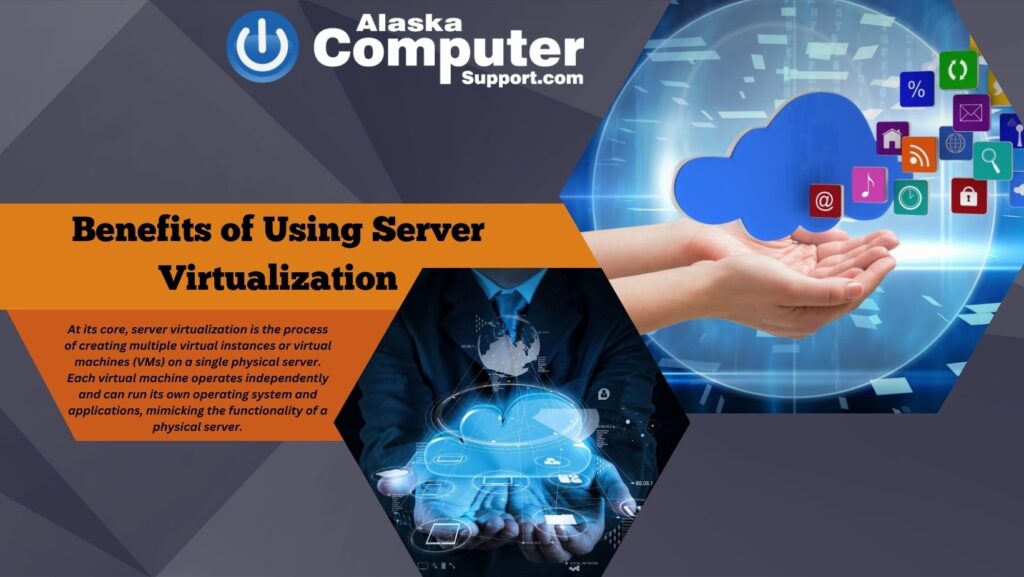The Benefits of Using Server Virtualization

Server virtualization has revolutionized the way modern businesses manage their IT infrastructure, offering numerous benefits and advantages. In this blog post, we will explore the concept of server virtualization, how it works, and delve into the various advantages it brings to organizations of all sizes.
Definition of server virtualization
At its core, server virtualization is the process of creating multiple virtual instances or virtual machines (VMs) on a single physical server. Each virtual machine operates independently and can run its own operating system and applications, mimicking the functionality of a physical server. By abstracting the underlying hardware, server virtualization enables the efficient utilization and management of computing resources.
Brief explanation of how server virtualization works
Server virtualization relies on a specialized software layer called a hypervisor, which acts as a virtualization platform. The hypervisor allows the physical server to be divided into multiple isolated virtual environments, each with its own set of resources. It manages the allocation of CPU, memory, storage, and network resources to ensure optimal performance and isolation between virtual machines. This abstraction of hardware resources enables better utilization, flexibility, and scalability.
Advantages of Server Virtualization
Server virtualization offers a range of advantages that have transformed the IT landscape. Let’s explore some of the key benefits that organizations can leverage:
Cost Savings
One of the most compelling advantages of server virtualization is the significant cost savings it brings to organizations.
Reduction in hardware costs: By consolidating multiple virtual machines onto a single physical server, businesses can reduce their hardware requirements. This consolidation eliminates the need for numerous standalone servers, reducing upfront costs, and minimizing ongoing maintenance expenses.
Lower energy consumption and reduced cooling needs: Running fewer physical servers results in reduced power consumption, leading to lower electricity bills and a smaller carbon footprint. Moreover, with fewer servers generating heat, cooling requirements are also reduced, further contributing to cost savings.
Enhanced Scalability and Flexibility
Server virtualization empowers organizations with the ability to scale and adapt their IT infrastructure rapidly.
Easy addition or removal of virtual servers: With virtualization, adding or removing virtual servers becomes a seamless process. Organizations can dynamically allocate resources to meet changing demands, enabling quick scalability without the need for purchasing and deploying physical servers.
Efficient resource allocation: The hypervisor intelligently manages resource allocation, ensuring that each virtual machine receives the necessary CPU, memory, and storage resources. This efficient utilization of resources enables organizations to maximize their infrastructure investments.
Increased Efficiency and Utilization
Server virtualization enhances efficiency and resource utilization within the IT environment.
Consolidation of multiple physical servers into a single host: By consolidating multiple physical servers into a single host, organizations can minimize server sprawl and eliminate underutilized resources. This consolidation optimizes hardware usage, reduces maintenance costs, and simplifies management.
Better utilization of server resources: Virtualization allows for fine-grained control over resource allocation. The ability to allocate CPU, memory, and storage on-demand ensures that resources are utilized efficiently, maximizing performance and minimizing waste.
Improved Disaster Recovery and Business Continuity
Server virtualization plays a vital role in enhancing disaster recovery and ensuring uninterrupted business operations.
Ability to create snapshots and backups of virtual machines: Virtualization platforms provide the ability to take snapshots of virtual machines, capturing their entire state at a specific point in time. These snapshots can serve as restore points and enable quick recovery in case of system failures or data corruption. Additionally, regular backups of virtual machines can be automated, ensuring critical data is protected and easily recoverable.
Quick restoration of services in case of hardware failure: In a virtualized environment, if a physical server fails, the affected virtual machines can be quickly migrated to another host without significant downtime. This rapid restoration of services minimizes business disruption and ensures continuity even in the face of hardware failures.
Simplified IT Management
Server virtualization simplifies IT management, making administrative tasks more efficient and streamlined.
Centralized management of virtualized infrastructure: Virtualization platforms often offer centralized management consoles or software, allowing administrators to monitor and control the entire virtualized infrastructure from a single interface. This centralized management simplifies tasks such as resource allocation, performance monitoring, and troubleshooting, reducing administrative overhead.
Streamlined deployment and provisioning processes: With virtualization, deploying new servers or applications becomes a standardized and automated process. IT teams can leverage templates and preconfigured virtual machines to rapidly provision new instances, eliminating the time-consuming and error-prone process of manually setting up physical servers. This streamlined deployment process accelerates time to market for new services and improves overall agility.
In conclusion, server virtualization offers numerous benefits that significantly impact businesses’ IT infrastructure. The cost savings achieved through reduced hardware expenses, energy consumption, and optimized space utilization are compelling. The enhanced scalability, flexibility, and resource utilization enable organizations to adapt quickly to changing demands. Additionally, the improved disaster recovery capabilities and simplified IT management empower businesses to ensure uninterrupted operations and streamline administrative tasks. Embracing server virtualization can transform the way organizations manage their IT infrastructure, driving efficiency, cost savings, and agility in an increasingly dynamic and competitive landscape.
